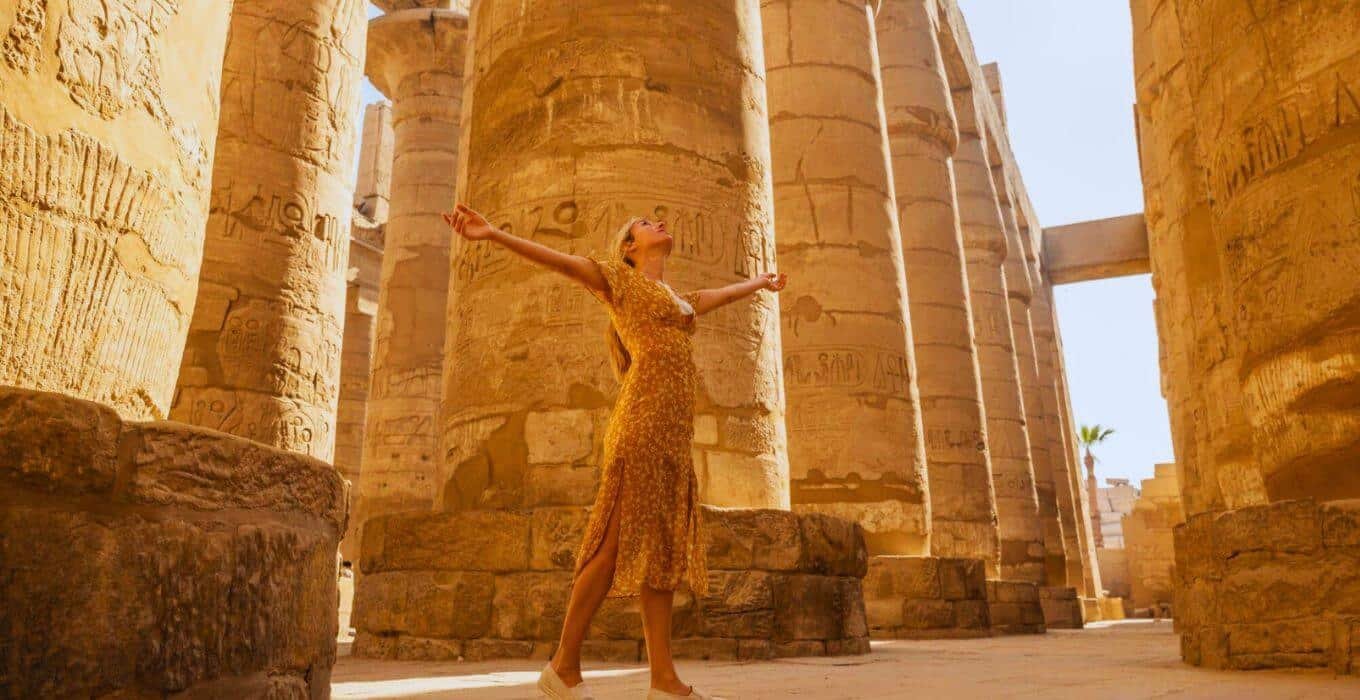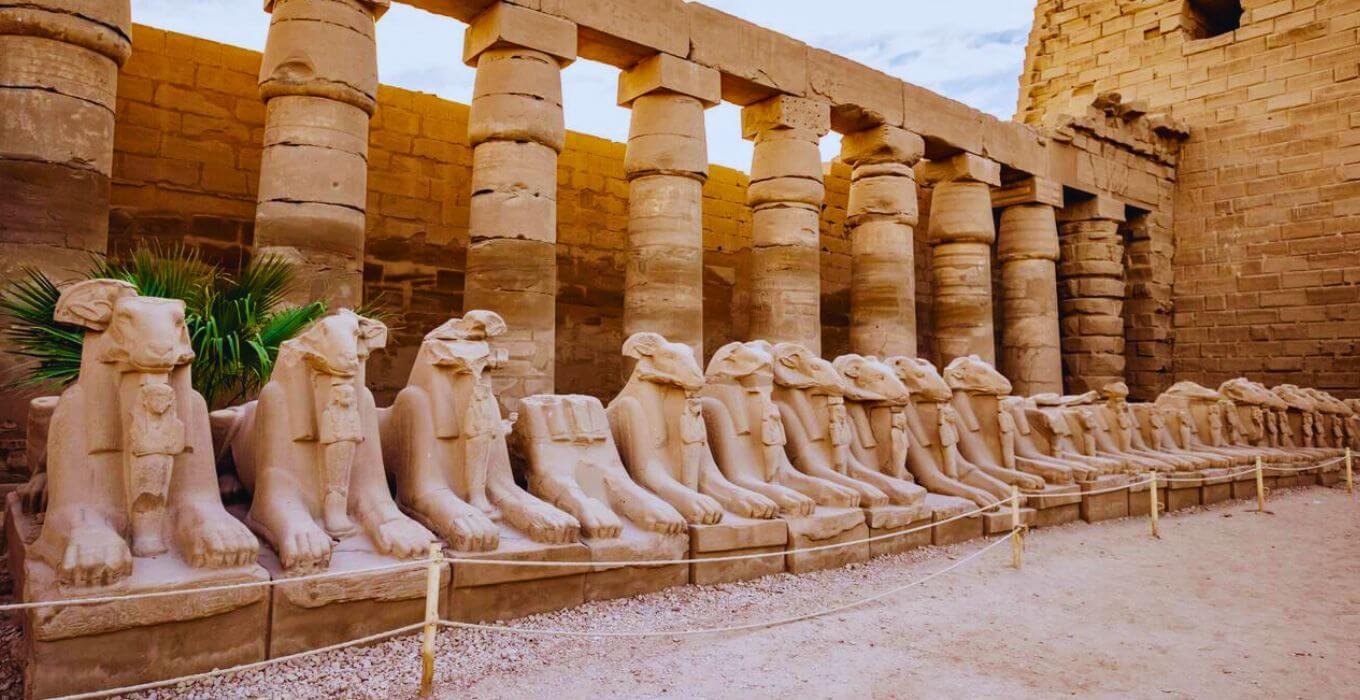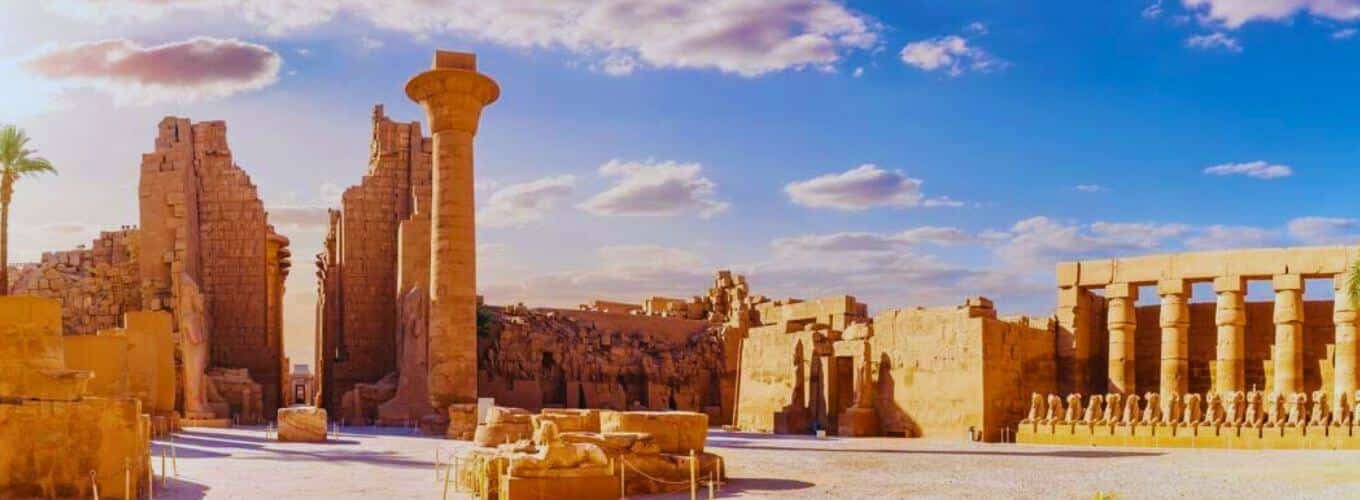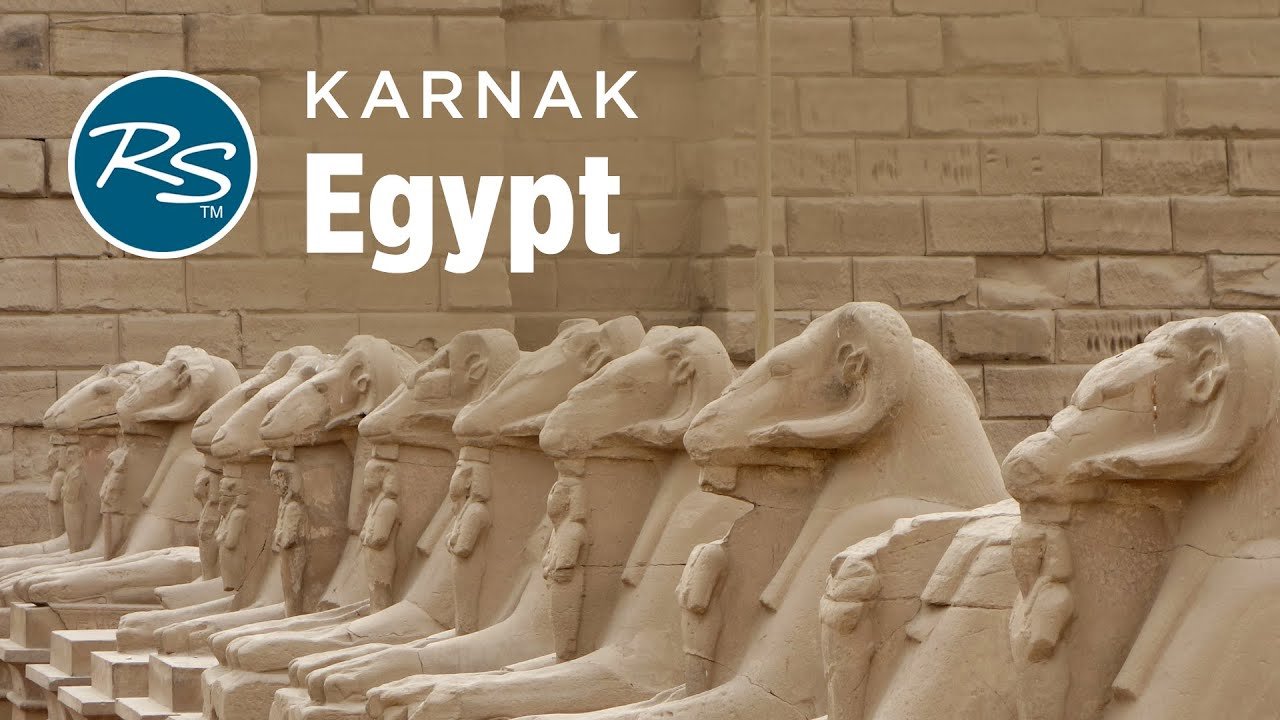What secrets hide in the 200-acre complex of Karnak Temple in Luxor, Egypt? This site, from around 1400 BCE, shows the grandeur of ancient Egypt. It reveals the deep faith of the ancient Egyptians. The world’s largest religious complex, Karnak Temple, amazes with its architecture and hieroglyphics.
Walk through the temple’s ruins, temples, chapels, and pylons. Each part is dedicated to Amun, Mut, and Khonsu. See the Hypostyle Hall with its 134 columns, each 80 feet tall. Learn about the rituals and ceremonies that happened here.
Discover the history and culture at Karnak Temple. It shows the ancient Egyptians’ skill in architecture and engineering.
Key Takeaways
- Karnak Temple Complex dates back to around 1400 BCE and covers over 200 acres.
- The Temple of Amun-Ra features a Hypostyle Hall with 134 massive columns reaching 80 feet tall.
- Luxor was the pharaohs’ capital and a hub of ancient Egyptian art, architecture, and cultural expression.
- Karnak Temple is the world’s largest religious complex and a must-visit destination in Egypt.
- Explore the ancient ruins, temples, and hieroglyphics that offer a window into ancient Egyptian history and beliefs.
Unveiling the Grandeur of Karnak Temple
Why is Karnak Temple Famous?
Karnak Temple is famous for many reasons. It’s the world’s largest religious complex, covering 200 acres. It started in 2055 BCE and took over 2,000 years to build. Pharaohs from different dynasties worked together, adding to it.
This long history shows the temple’s architectural diversity. It’s a symbol of ancient Egyptian religion’s strength.
The temple’s size is truly impressive. The Great Hypostyle Hall has 134 huge columns, some up to 80 feet tall. It’s so big, it could fit the Notre Dame Cathedral inside.
Karnak Temple is more than just big. It gives us a peek into ancient Egyptian beliefs. It was dedicated to the Theban Triad of Amun, Mut, and Khonsu. The carvings and hieroglyphs tell us a lot about their Amun-Ra mythology and rituals.
Karnak Temple is a key part of Egyptian tourism. It’s the second most visited site in Egypt, after the Pyramids of Giza.
“Karnak Temple is a true testament to the ingenuity and enduring spirit of ancient Egyptian civilization. Its sheer scale and architectural complexity are simply breathtaking.”

Journey Through Time: Karnak Temple’s Millennia-Long History
The Karnak Temple Complex in Luxor, Egypt, has a history spanning over two millennia. It is a marvel of architecture and the second most visited site in Egypt after the Pyramids. Since 1979, it has been a UNESCO World Heritage Site, showing its lasting importance.
The temple’s story begins in the Middle Kingdom period, around 2055 BCE. It was a key religious and administrative center back then. Pharaohs from different dynasties, including the famous New Kingdom rulers, added to the temple over time.
In the New Kingdom era, the temple reached its peak under pharaohs like Hatshepsut and Ramesses II. They built massive obelisks, pylons, and the stunning Hypostyle Hall. These structures show the temple’s grandeur and the power of ancient Egyptian civilizations.
But, the temple’s glory faded in the Late Period. The pharaohs’ power declined, and Egypt faced invasions. The rise of Christianity in the Roman era led to the temple’s closure and abandonment. This caused it to deteriorate and get buried under sand and debris.
Despite all this, Karnak Temple still stands as a symbol of ancient Egyptian culture. It attracts visitors worldwide with its majestic ruins and the stories they tell.
Relics of a Bygone Era: The Glory of Karnak Temple
Karnak Temple in Luxor, Egypt, is a huge architectural wonder. It shows the greatness and creativity of ancient Pharaohs. At its center is the Hypostyle Hall, a true marvel of architecture from the Pharaonic era.
The Hypostyle Hall is breathtaking, with 134 massive columns, some as tall as 80 feet. It’s so big, it could fit the famous Notre Dame Cathedral inside. Each column is carved with detailed hieroglyphs and scenes of Pharaohs worshiping gods. This shows the amazing skill and detail of ancient Egyptian builders.
|
Architectural Marvels of Karnak Temple |
Dimensions |
|
The Great Hypostyle Hall |
134 columns, up to 80 feet tall |
|
Towering Obelisks |
Some reach over 100 feet in height |
|
Imposing Pylons |
Massive gateways up to 250 feet tall |
|
Expansive Courtyards |
Covering an area of over 200 acres |
Outside the Hypostyle Hall, the Karnak Temple Complex has many more wonders. There are huge obelisks, massive pylons, and big courtyards. All these add to the site’s grandeur and show the lasting achievements of the Pharaohs.
“The Karnak Temple Complex in Luxor is one of the largest temple complexes in Egypt, covering an area of approximately 200 acres and comprising a vast mix of decayed temples, chapels, pylons, and other buildings.”
The Avenue of Sphinxes: A Grand Processional Way
Visitors to Karnak Temple are amazed by the Avenue of Sphinxes. This grand path once linked the temple to the Luxor Temple. It stretches for 2.7 km (1.7 mi) and was once flanked by over 1,057 sphinx statues.
The sphinxes, with their human heads and lion bodies, were seen as guardians. They symbolized the power of pharaohs. Walking the Avenue of Sphinxes was a spiritual experience. It was a key part of ancient ceremonies and festivals at Karnak Temple.
The Avenue of Sphinxes, also called the King’s Festivities Road, is about 5,000 years old. It was mainly built during Amenhotep III and Nectanebo I’s reigns. It has been restored to help make Luxor City a huge outdoor museum.
The Avenue of Sphinxes reopened in 2021 after a big renovation. This shows Egypt’s dedication to keeping its ancient architecture alive.
Karnak Temple: A Living Chronicle of Ancient Egypt
Karnak Temple is a symbol of ancient Egypt’s lasting legacy. It has a history of over 2,000 years. Located in Luxor, it was a center of religious and political life. It hosted the Opet Festival and a nightly sound and light show.
The construction of Karnak Temple started around 2055 BCE. Each pharaoh added something new. The temple’s mix of styles shows the skill of ancient Egyptian craftsmen.
The temple complex is huge, covering 200 acres. The Great Temple of Amun is its heart. It has a famous Hypostyle Hall with 134 massive columns.
Karnak Temple was key to ancient Egyptian life. Its sacred lake was used for ceremonies. The “Road of Rams” had over 1,200 sphinxes, showing the pharaohs’ power.
Despite damage over the years, Karnak Temple still stands strong. It shows the greatness of ancient Egypt. Visitors can learn a lot about Karnak Temple History, Ancient Egyptian Civilization, Pharaohs, and Religious Significance here.
Exploring the Temple Complex: Highlights and Tips
The Karnak Temple complex in Luxor, Egypt, is a must-see for travelers. It covers over 200 acres and is filled with ancient wonders. You’ll see towering obelisks, massive columns, and a peaceful Sacred Lake.
Unmissable Sights
- The Great Hypostyle Hall, with its 134 towering columns, some reaching up to 70 feet in height.
- The imposing obelisks of Thutmose I and Hatshepsut, standing as testament to the pharaohs’ architectural prowess.
- The serene Sacred Lake, which was likely used for ritual ablutions by the ancient Egyptians.
- The Festival Hall of Thutmose III, showcasing the pharaoh’s legacy through intricate carvings and inscriptions.
- The Avenue of Sphinxes, which once connected Karnak Temple to Luxor Temple, offering a grand processional way.
- The towering pylons that mark the various entrances to the Karnak Temple complex.
Best Time to Visit
Visit Karnak Temple in the early morning or late afternoon for the best experience. This avoids the hot midday sun. The soft, golden light makes the temple’s beauty even more striking.
Don’t miss the Karnak Temple sound and light show in the evenings. It dramatically tells the temple’s history. A guide can help you understand the temple’s rich past, making your visit unforgettable.

Luxor Temple: A Companion Site to Karnak Temple
Karnak Temple is a highlight of ancient Egyptian architecture. But Luxor Temple, just a short distance away, is also a must-see. It offers a unique look into the city’s architectural and religious past.
Started by Amenhotep III around 1400 BCE, Luxor Temple was later expanded by Ramses II. It was a key place for the Opet Festival. This festival celebrated the gods Amun, Mut, and Khonsu’s journey from Karnak to Luxor.
When you arrive at Luxor Temple, you’ll see its grand entrance pylon. It’s flanked by statues of Ramses II and an avenue of sphinxes. Inside, you can see the Colonnade of Amenhotep III and the inner sanctum where the sacred barque of Amun was kept.
The walls of Luxor Temple show scenes of religious rituals and the birth of Amenhotep III. These scenes highlight the pharaoh’s divine status. Together, Karnak and Luxor Temples give a full view of ancient Egyptian culture.
“Luxor City is considered the greatest open-air museum in the world, known for its ancient monuments.”
Luxor Temple, as a companion to Karnak, showcases ancient Egypt’s architectural and religious genius. Visitors will be amazed by the scale, details, and history of these two sites.
Decoding the Hieroglyphs: Unveiling Ancient Mysteries
The walls, columns, and obelisks of Karnak Temple are covered in hieroglyphic writings. These symbols, seen as the “language of the gods,” reveal much about ancient Egyptian life. They show the religious beliefs, myths, and historical events of the time.
Exploring the hieroglyphs lets us discover Karnak’s hidden stories. We learn about rituals, ceremonies, and the pharaohs’ achievements. The artistry in these inscriptions shows the intelligence and creativity of ancient Egyptian civilization.
The Language of the Gods
Unlocking the ancient Egyptian language of hieroglyphs was a big challenge. The discovery of the Rosetta Stone in 1799 was a major breakthrough. It had the same text in Greek, Demotic, and hieroglyphics.
After 20 years of work, Jean-François Champollion cracked the code. He deciphered the hieroglyphic system. This opened up a lot of knowledge about Karnak Temple Mysteries and ancient Egypt’s history. Understanding this language helps us see the importance of Karnak Temple in ancient Egyptian culture.
“The Rosetta Stone was key in deciphering ancient hieroglyphics. It took more than 20 years to translate hieroglyphs after the discovery of the Rosetta Stone.”
Guided Tours: Unlocking the Secrets of Karnak Temple
To fully immerse yourself in the grandeur and history of Karnak Temple, a guided tour is highly recommended. Experienced guides can provide invaluable context and insights, unlocking the Karnak Temple Secrets hidden within the temple’s walls and columns. As you explore the vast complex, your guide will share their deep knowledge of the site’s architecture, religious significance, and the important role it played in ancient Egyptian society.
Your guide can help you navigate the intricate layout, pointing out the must-see highlights, such as the Hypostyle Hall, the Avenue of Sphinxes, and the sacred sanctuaries dedicated to the Theban triad. They can also offer insights into the hieroglyphic inscriptions, helping you decipher the language of the gods and understand the cultural and historical significance of the site.
By joining a Guided Tour, you’ll gain a deeper appreciation for Karnak Temple’s enduring legacy and leave with a renewed sense of wonder and respect for the achievements of ancient Egyptian civilization. For those seeking to truly immerse themselves in the Luxor Attractions, a guided tour of Karnak Temple is an essential part of the experience.
|
Guided Tour Highlights |
Key Facts |
|
|
“By joining a guided tour, you’ll gain a deeper appreciation for Karnak Temple’s enduring legacy and leave with a renewed sense of wonder and respect for the achievements of ancient Egyptian civilization.”
Conclusion
Karnak Temple is a symbol of ancient Egypt’s lasting power and beauty. It covers over 200 acres and is a masterpiece of architecture and engineering. The pharaohs’ work here over 2,000 years shows their skill and dedication.
The temple’s highlights include towering obelisks, massive pylons, the Hypostyle Hall, and sacred areas for the Theban triad. These features give visitors a deep look into ancient Egyptian beliefs and achievements.
Exploring the temple’s ruins and reading the hieroglyphs takes you back in time. It shows the strength and creativity of this ancient civilization. Whether you love history, architecture, or just want to dive into culture, Karnak Temple in Luxor is a must-see.
Leaving the temple, you’ll have a new respect for the pharaohs and ancient Egypt’s timeless charm. For those planning a Nile cruise, the Egypt Cruise Planners team can help you discover Karnak Temple and Luxor’s other attractions. It’s a chance to see the temple’s grandeur and dive into its rich history.
Read other related articles:

